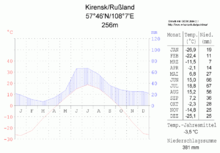Kirensk
| city
Kirensk
Киренск
|
||||||||||||||||||||||||||||||||||||||||
|
||||||||||||||||||||||||||||||||||||||||
|
||||||||||||||||||||||||||||||||||||||||
| List of cities in Russia | ||||||||||||||||||||||||||||||||||||||||
Kirensk ( Russian Киренск ) is a city in Irkutsk Oblast ( Russia ) with 12,640 inhabitants (as of October 14, 2010).
geography
The city is located about 700 km north of the Oblast capital Irkutsk at the confluence of the Kirenga in the Lena .
The city of Kirensk is the administrative center of the raion of the same name .
There are no year-round road connections to Kirensk; The city can only be reached in winter via a road that partially runs over the ice of the Lena. The city has an airport and a river port.
climate
The climate is strictly continental . The annual mean temperature is −3.5 ° C, the mean July temperature is +18.8 ° C, the mean January temperature is −26.9 ° C. The mean annual amount of precipitation is 381 mm with a maximum in the summer months.
history
Kirensk was founded in 1630 by Cossacks under the name Nikolsky pogost . In 1639 Jerofei Khabarov had a salt works built. The place developed into an important trading center on the route to Yakutsk . From 1650 fairs took place and a customs post was set up. 1665 was Ostrog built and the place in Kirenski ostrog renamed after the opening out here in the Lena Kirenga (of Evenki kiri for dirt , so dirty river as gravel and stones in many sections of the river of manganese compounds are colored dark).
In 1775 the place was raised to the district seat of the Irkutsk governorate .
In the 19th century, Kirensk was a place of exile for political prisoners. B. Józef Piłsudski and Ales Harun .
During the First World War, the German ethnologist Oskar Iden-Zeller and his wife Anita Iden-Zeller stayed as exiles in the city. A description of their stay and the life of the exiles in the city can be found in their book The Path of Tears .
In 2001 Kirensk was badly affected by a flood of the Lena, but not practically completely destroyed like the Lensk downstream .
Population development
| year | Residents |
|---|---|
| 1897 | 2,280 |
| 1926 | 4,694 |
| 1939 | 12,786 |
| 1959 | 14,412 |
| 1970 | 14,453 |
| 1979 | 16,154 |
| 1989 | 16,137 |
| 2002 | 13,712 |
| 2010 | 12,640 |
Note: census data
Culture, education and sights
In the city center, which is on an island between Lena and Kirenga, a number of wooden houses from the 19th and the beginning of the 20th centuries have been preserved, such as the former wine storage (or liquor storage ) from 1906 to 1912.
There is a local museum.
economy
In Kirensk there are companies for ship repair, wood processing and the food industry.
Individual evidence
- ↑ a b Itogi Vserossijskoj perepisi naselenija 2010 goda. Tom 1. Čislennostʹ i razmeščenie naselenija (Results of the All-Russian Census 2010. Volume 1. Number and distribution of the population). Tables 5 , pp. 12-209; 11 , pp. 312–979 (download from the website of the Federal Service of State Statistics of the Russian Federation); Itogi Vserossijskoj perepisi naselenija 2010 g. po Irkutskoj oblasti (Results of the All-Russian Census 2010 for Irkutsk Oblast). on-line
Web links
- City's unofficial website (Russian)
- Kirensk on a private website (Russian, with many photos)
- Kirensk on mojgorod.ru (Russian)




